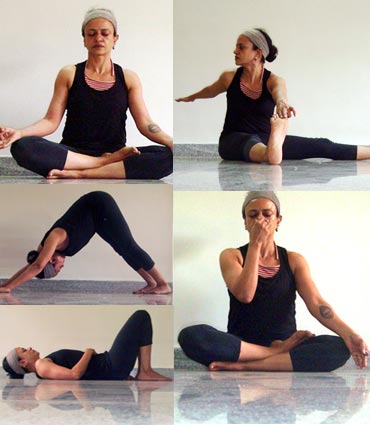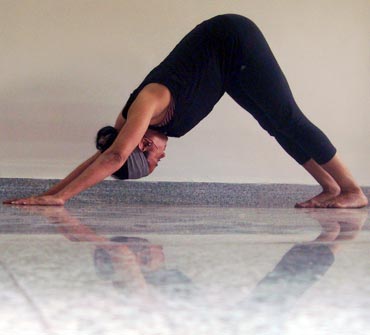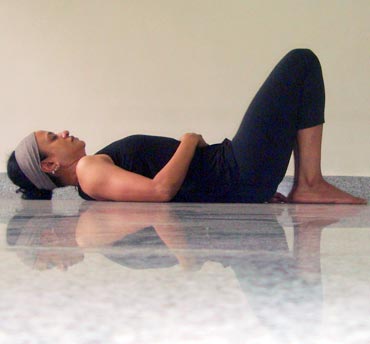 | « Back to article | Print this article |
Yoga poses to lower high blood pressure
Shameem Akthar, yogacharya, trained with Trivandrum's Sivanananda Yoga Vedanta Center, leads you through five yoga poses that will help tackle circulatory problems.
You must appreciate the mechanism of blood circulation to know why high blood pressure occurs.Our blood circulation is serviced by a 100,000-mile network which works non-stop to transport blood, oxygen, nutrients, repairing and protecting agents to various organs in our body. At the centre of all this exhausting activity is our heart which works non-stop.
Sensors in this system keep track of when our blood pressure should be high and it must be low. But when the mechanism turns faulty we suffer from either high or low blood pressure.
High blood pressure occurs when the arteries are constricted (due to lifestyle habits including an indifferent diet, sedentary life or inability to handle stress). The heart must work harder against this pressure.
Cholesterol deposits on arteries add to this burden of the circulatory system and are also due to mismanaged diet. Yogic therapy for blood pressure thus calls for a complete overhaul of our diet.
This involves limiting fat intake (saturated oils), meat products, over-cooked, refined food (including biscuits or canned stuff) and including more fibre through whole grains, vegetables and fruits.
Unlike with diabetics who can plunge right into intermediate or advanced levels depending on personal capacity, a person with blood pressure must start off lightly with yoga. The simple pawan muktasana series are best way to iron out the initial stiffness that blood pressure causes in the body.
In four-to-five weeks of regular practice of these series, the body is primed for other poses. Moving into the second stage of yogic therapy too fast may be counter-productive because some poses are counter-indicated initially for BP but allowed later if learnt in a phased manner.
This yogic rule is rather stringent for those with blood pressure patients.
For more of Shameem's yoga writings visit http://jaisivananda.blogspot.com. Follow Shameem's yoga products on her online shop here. Shameem's second book Yoga in the workplace, with photographs by ace photographer Fawzan Husain, is now available at online shops and bookshops across the country.
Disclaimer: This column just shares the columnist's passion for yoga which is ideally learned under the guidance of an expert.
Parvatasana (Inverted V/Mountain pose)
Sit on your fours. Inhale. Exhaling, lift off the hips, as shown, with legs straight. Focus should be on pressing down heels, and then from the shoulders. This may not be initially possible, but comes with practice and flexibility.
Continue normal breathing. Hold for five to ten seconds. Relax back on fours. Repeat thrice.
Benefits: Is therapeutic in several ailments: back problems, circulatory, skin diseases.
One of the most powerful cure-all poses.
Ujjayi (Victory breathing)
Sit in any cross-legged position. Hold hands in mudra (hand gesture as shown). Shut eyes. Now breathe from the nose but make a soft snoring sound from the throat. This comes from contracting the epiglottis.
Inhale and exhale for the same duration, making the same sound for both. One inhalation-exhalation form one round. Do up to nine rounds initially.
Benefits: A cure-all pranayama, lowers blood pressure immediately. Calms the mind.
Apanasana (Downward breathing pose)
Lie on back as shown, with knees bent, feet flat, close to hips. One hand on stomach, other alongside body.
Shut eyes. Focus on the breathing and the rise and fall of the stomach as you inhale and exhale.
Count the breathing, with one inhalation and exhalation as one, and moving up to 50 or so. This may even take ten minutes or more if your breathing is slow and steady. Release the pose by moving body gently, opening the eyes.
Done in the morning and evening, it can have near-miraculous effect on the body and mind.
Benefits: Boosts breathing. Calms the master glands. Has miraculous impact on health.
Is therapeutic in several ailments.
Nadi shodhana (Energy channel purifying breathing practice)
Sit crosslegged. Use right hand to release and shut nostril, as shown. Left hand in the mudra as shown, index finger tip touching thumb tip.
Inhale and exhale deeply a few times. Then shut right nostril with right thumb, inhale from left to count of four, and shut nostril for two seconds and exhale to a count of six or eight. (The ratio of this changes, and this is the minimum, meant to acclimatise those with blood pressure problem to a higher ratio).
Inhale from the left, hold for two seconds, and exhale from right for eight counts. This is one round. Initially do five rounds. Then work up to ten rounds. The ratio may be modified according to expert advice.
Benefits: A cure-all practice, heals both mind and body. Calms the mind. Soothes the major glands which give the cues to the body, including how much pressure must be maintained during blood pressure.
Druta merudandasana (Dynamic spinal twist)
Sit with legs apart as shown. Hands should be at shoulder level.
Inhale. Exhaling twist to right side, with left hand touching right leg where you can (at the foot or ankle or shin or knee, depending on flexibility). Look at the right hand.
Inhale, returning to center. Exhale, twist to left side, right hand touching left leg, looking back at left hand. Inhale, return to centre. This is one round. Do up to five to ten rounds, slowly.
Benefits: Clears stiffness of body which blocks blood flow. Soothes tensions away. Boosts flexibility, breathing, circulation and mood.





